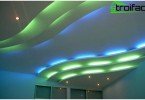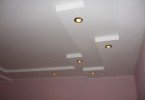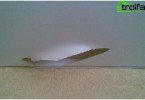Ceiling decoration always takes a lot of thoughts of the owners. After all, I want it to turn out beautifully, and inexpensively, and quickly, and efficiently. But any work related to finishing plaster does not last for one day and requires significant financial injections. In addition, in a few years it will be necessary to refresh the surface. Fabric stretch ceilings are an aesthetics for the lazy. The cost of such ceilings, even with installation, will be less than the materials for plastering. Installation itself will take no more than a few hours. And color solutions can satisfy even very intricate design ideas, since fabric ceilings can be painted, applied any pattern manually or using photo printing.
Content
- Truth and fiction about fabric ceilings
- The real benefits of fabric
- Myths and real qualities
Truth and fiction about fabric ceilings
Modern solutions of stretch ceilings made of fabric appeared relatively recently, but have already managed to grow into myths. This is largely due to the desire of the manufacturer and sales agents to advertise their goods and has led to the attribution of completely absurd or contradictory qualities to fabric webs. On fabric stretch ceilings, the reviews of real owners also vary greatly: from laudatory to disappointed. Therefore, we will try to distinguish between myths and reality.
The real benefits of fabric
- Temperature Resistance. The temperature range of operation of fabric cloths ranges from – 40 ° C to + 80 ° C. This allows you to install them in unheated rooms, for example, terraces, porches, balconies, loggias, in newly built houses.
- Seamlessness. Fabrics are available in various widths, the maximum is 5.1 m. This is enough to stretch the fabric seamlessly in most rooms. If the width of the room exceeds 5 m, then the installation of a fabric stretch ceiling on the entire surface is impossible, since the paintings do not connect.
- Strength. Cloths are not easy to scratch or accidentally damage with a sharp object, knife or dart..
- No exact measurements required for installation. The stretch ceiling canvas is purchased with a margin, and then the excess is cut off.
- Ease of installation. Fabric stretch ceilings do not require work with a heat gun, heating the room. All work comes down to mounting the baguette and tensioning the canvas.
- Material is off.
- Not electrified.
- Can be repainted with acrylic paints up to 4 times.
Myths and real qualities
- Environmental friendliness. The material for fabric ceilings is completely synthetic polyester impregnated with polyurethane. In some exceptional cases, the canvases produce their fiberglass or natural fibers, but their naturalness is reduced completely to zero by impregnation with polyurethane. In fact, arguing that fabric ceilings are environmentally friendly, it is understood that they do not stink and do not emit fumes even when heated. This ends with environmental friendliness. On the other hand: most of the clothes are now made from the same polyester, so if you wear similar clothes, then the synthetic stretch ceiling will not play any role.
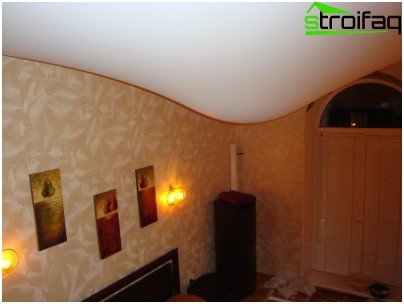
Only PVC stretch ceiling can hold water in case of flooding, flexing elastically
- Protects against flooding. The fabric stretch ceiling is really waterproof, for this it is just soaked with polyurethane. The durability of the canvas is also sufficient to withstand the high pressure of water. But there is one significant nuance. The fabric ceiling is inelastic, does not stretch like PVC, so in case of severe flooding, most likely, the fabric will break out of the mounts, and the water will still pour into the room.
- Breathability. This myth appeared due to the large knitting of the canvas, in which pores are visible. Manufacturers themselves doubt that their canvases pass air. So the fabric ceiling does not “breathe” like any synthetics.
- Easy operation. The fabric absorbs odors and dust accumulates on it. You can’t call it practical. Although the owners claim that the ceiling is easy to clean with a normal rag and soapy water.
Which is better: fabric or PVC
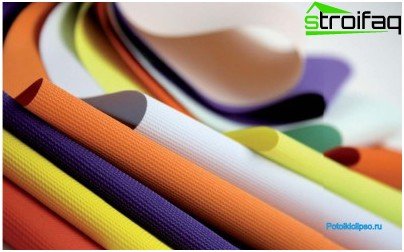
Fabric stretch ceilings are available in 20 standard colors
How to choose a suspended ceiling depends primarily on the operating conditions and on the personal preferences of the owner. I would immediately like to clarify that fabric ceilings are more expensive than PVC ceilings by at least 1.5 – 2 times.
If we consider the issue of aesthetics and color diversity, then, of course, PVC ceilings win in all respects. There are more than 200 standard color solutions for PVC films, while for fabric webs – no more than 20 pieces. Fabric ceilings can be painted with acrylics, apply any drawings or photo printing, but the image will always turn out faded. It is also impossible to make the fabric ceiling glossy. While the pattern on the PVC film is so realistic that it can immerse into the atmosphere.
Most often, the fabric ceiling is similar to high quality plastered, and this is its main advantage. If you do not want to mess with the plaster, you can safely use the suspended ceiling.
PVC films are afraid of low temperatures, already at 0 ° C it begins to crack, so in open and unheated rooms it is only necessary to install fabric stretch ceilings.
The undeniable advantage of fabric ceilings is the ease of installation compared to PVC. It takes much less time and does not require special equipment and skills. Also, during installation, the canvas is difficult to tear or damage.
In large rooms, a fabric ceiling is preferable, since its width is 5 m. If you install a PVC ceiling, then your paintings will have to be welded. This seam is a weak point in the structure. It is not visible to the naked eye, but if you focus on it, so to speak, “catch your eye”, then even on a plain surface it is noticeable.
A significant drawback of the PVC ceiling is that with the beginning of the heating season, the film begins to exude an unpleasant technical smell. Many owners complain about this. This property is completely devoid of fabric. So, choosing a stretch ceiling, you will have to weigh many pros and cons so as not to be mistaken.
DIY installation technology
The domestic market offers products of only two well-known companies, these are fabric stretch ceilings Clipso (Switzerland) and Descor (Germany). The Descor blade is slightly thinner, so it can be secured with a bead or wedge method.
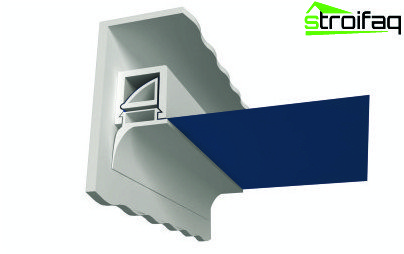
Some Descor webs can be fastened
A universal option for mounting a fabric stretch ceiling is clip fasteners. You can do it yourself in just a couple of hours, but you will have to call a friend to help.
Simple preparatory work
First you need to measure the distance from the floor to the ceiling mounting level. The minimum gap between the ceiling and the canvas can be 2 cm. Then, the lowest point is determined and the level of the future stretch ceiling is applied from it using a construction thread around the entire room.
Installing a wall baguette or profile
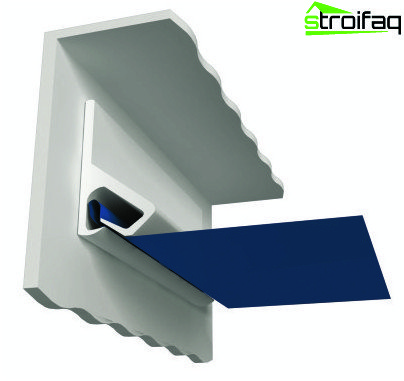
The most common way of attaching fabric suspended ceilings is clip fasteners
To fix fabric stretch ceilings, a special baguette made of durable plastic is sold, which has a snap-on clip that holds the fabric inside. We trim the slats of the baguette at an angle equal to half the angle of the room to connect them.
We fix the baguette to the wall or ceiling (there is a separate type of baguette for this) around the perimeter of the room. We fix the fixtures in 10 cm increments. We drill holes, then insert the dowels into them, attach the baguette and fix it with screws.
Tensioning and securing the fabric
Cloth fabric ceiling is most often sold in bundles. It must be removed from the packaging and straightened. Then the canvas should be taken together, one will be temporarily fixed, and the other to maintain weight. Using a special rounded spatula, the canvas is refilled in a baguette. First you need to make temporary fasteners at a distance of 50 – 70 cm from each other. At least 30 cm from the corner.
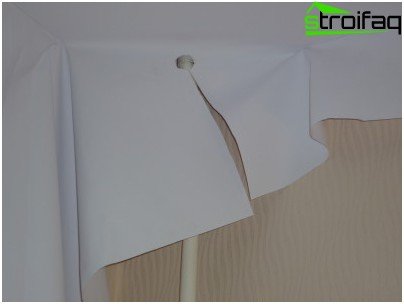
The stretching of the fabric of the stretch ceiling should start from the walls and end in the corners
We start to fill the canvas with a short wall, then with the opposite from it. Last but not least, to the long walls. Carefully pull the canvas and roll it into a baguette with a rounded spatula. It is necessary to move from the middle of the wall to the corners. Last fixed corners.
When the canvas is fully fixed in a baguette, we cut off the excess with a clerical knife. In order not to damage the canvas, put a long spatula under the baguette and make a cut under it.
If small waves appeared during the tensioning process, you can get rid of them by heating the canvas with a hairdryer in this place. Installation of decorative skirting is done only after finishing walls.
As you can see, the process of installing a fabric stretch ceiling is quite simple and does not require special knowledge. To make it easier to understand the installation technology, we suggest watching a video that describes two different installation methods.
Photo – examples of fabric stretch ceilings
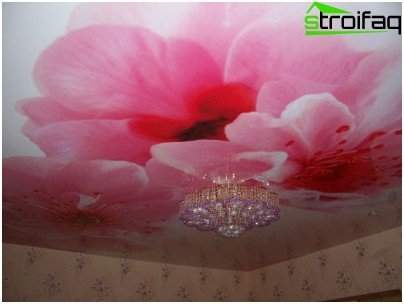
Photo printing of flowers on a stretch ceiling fabric
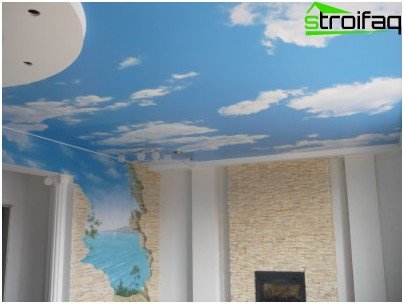
Cloths of fabric stretch ceilings are good in that they can be used for wall decoration, forming the whole composition
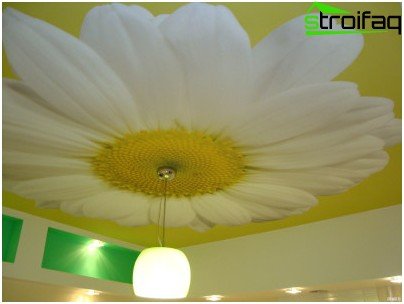
Using photo printing on the surface of the fabric stretch ceiling, you can apply any image
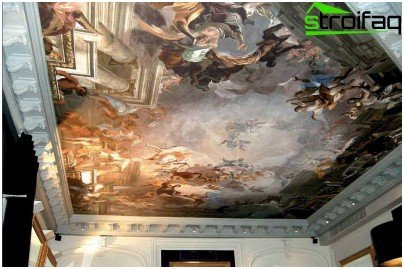
Entire paintings can be painted on the surface of a fabric ceiling using art painting
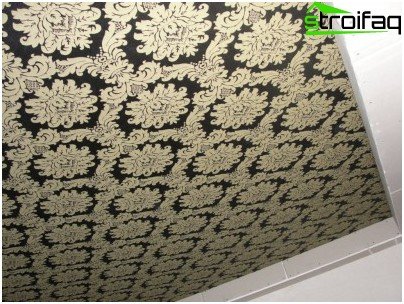
Appliques can be applied to the fabric ceiling.
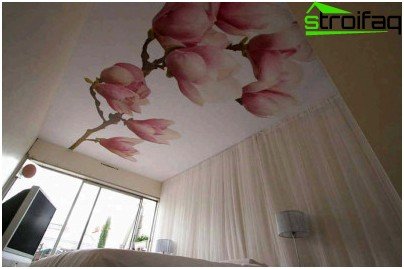
Canvas stretch ceiling can be painted with acrylic paints



